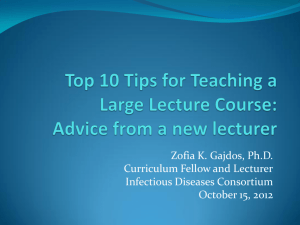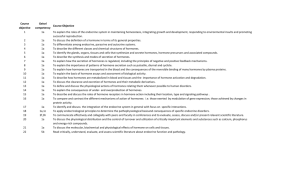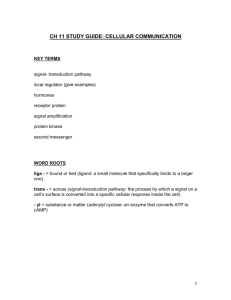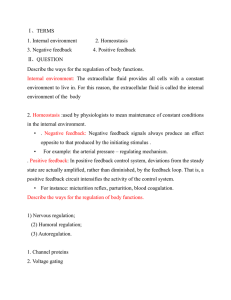Nervous System - Misericordia University
advertisement
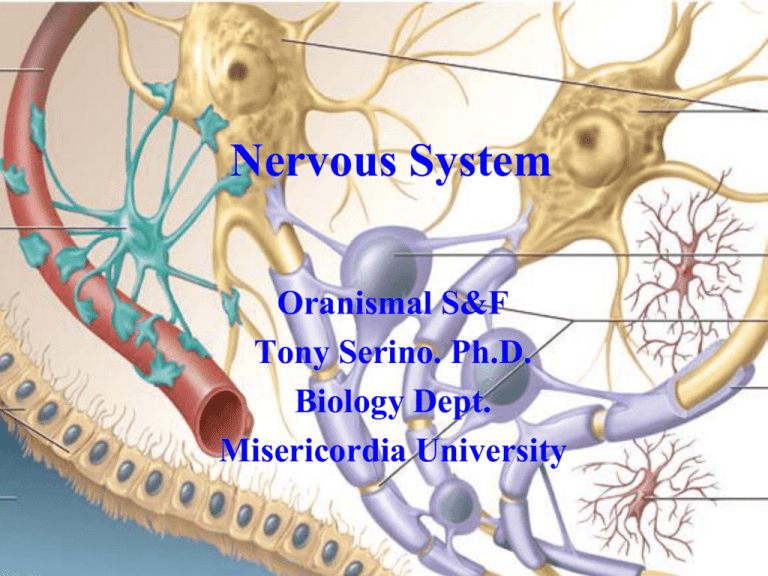
Nervous System Oranismal S&F Tony Serino. Ph.D. Biology Dept. Misericordia University Nervous System • Controls and/or modifies all other systems • Rapid response time • Usually short duration Lecture Outline: • General anatomy and physiology of neurons Functional Areas Divisions of the Nervous System Nervous Tissue • Non-excitable Tissue (Supportive cells) – Neuroglia –present in CNS – Schwann and Satellite cells –present in PNS – Create myelin, protect and nurture neurons • Neurons (excitable tissue) – Initiate and conduct electrical signals (action potentials) Neuron Anatomy Axonal terminal Nerve ending Synaptic boutons Synaptic knobs Functional Zones of a Neuron Receptor Zone Initial segment of Axon (trigger zone) Nerve endings Axon Node of Ranvier: gaps in myelin sheath Synapses • Areas where neurons communicate with other cells • Can be chemical (with neurotransmitters) or electrical (gap junctions) Anatomy of Synapse (chemical) Neurotransmission ends when NT diffuses away, re-absorbed by presynaptic neuron, or NT metabolized (degraded) by enzymes in cleft Membrane Potentials • Produced by the unequal distribution of ions across a selectively permeable membrane • The inside of the cell is called negative by convention • The intensity of the ion difference is expressed as voltage (measured in millivolts (mV)) Measuring Membrane Potentials Resting Membrane Potential Parameters necessary to create a resting membrane potential: •A semi-permeable membrane •Distribution of ions across membrane •Presence of large non-diffusible anions in interior •Na-K pump (3 Na+ out for every 2 K+ in) Gated Channel Proteins • Opening gate allows ions to travel into or out of the cell thereby changing the membrane potential • Can be controlled chemically or electrically Chemically Gated Channel Protein Voltage (electrically) Gated Channel Protein Graded Potentials Depolarization Inside of cell becomes less negative •Transient •Decremental •Due to chemically gated channels opening •Can be summated •May be excitatory or inhibitory Will only trigger AP if the threshold of the neuron is reached. Hyperpolarization Inside of cell becomes more negative Graded potentials magnitude vary with stimulus strength Action Potentials • Wave-like, massive depolarization with rapid repolarization • Propagated down entire length of axon or muscle cell membrane • All or none • No summation possible • Due to opening of voltage gated channels and corresponding positive feedback cycle established Endocrine System • Controls and modifies the internal environment by releasing chemicals (hormones) into the blood • Slower response time but longer duration of action compared to nervous system Chemical Messengers (hormones) • Hormone –secreted by cell into blood and acts on another cell some distance away • Neurohormone –secreted by neuron into blood to affect a target cell some distance away • Local hormones –secreted by cell into interstitial fluid to affects cells nearby – Paracrines –affect neighboring cells – Autocrines –affect the secreting cell • Pheromones –secreted by cell onto body surface to affect cells of another individual Hormones • Chemical Classification – Amines –single or few amino acids, most water soluble • Epinephrine, Thyroxine (but water insoluble), Melatonin – Proteins –short to long chains of amino acids; water soluble • GH, FSH, LH, Insulin, Glucagon, ADH, etc. – Steroids –derivatives of cholesterol; water insoluble • Estrogen, Testosterone, Progesterone, Cortisol, Aldosterone Steroid Hormones Characteristics Common to all Hormones • Must have target cell with appropriate receptor molecules • Receptor-hormone complex must trigger events in target cell that changes its physiology • Mechanisms for deactivating the hormone response must be present Controlling Hormone Response • Half-life of the hormone • Physiological range • Modifying target cell response – Up and down regulation • Turning off secretion – Negative feedback – Control by other hormones, neurons and metabolites Control of Hormone Secretion Mechanisms of Hormone Action 2nd messengers Water Soluble Water Insoluble Carrier protein nd 2 Messengers: cAMP 2nd Messengers: IP3 and Ca++-Calmodulin Steroid Hormone Transduction Different Styles of Secretion • Prohormone –a hormone that is made as a larger (inactive form) that must be changed prior to secretion (allows for storage of hormone in secreting cell) Ex.: proinsulin, pro-opiomelanocortin • Prehormone –a hormone that is secreted in an inactive form that must be changed near or in the target cell Ex.: Thyroxine, Angiotensinogen Proinsulin Types of Endocrine Disorders • Hypersecretion – Too much secretion of the hormone • Hyposecretion – Too little secretion of hormone • Hyporesponsiveness – Normal secretion, but little to no response by target cells Endocrine Glands






